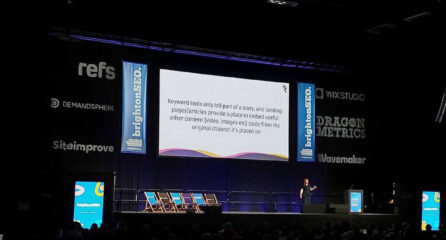It’s 6.30 a.m and the alarm goes off, the first thing I do? Reach for my phone. I check Twitter, Instagram, Facebook, and the Daily Mail BBC news app. Only then do I even consider getting out of bed.
Sound familiar?
It should. A study by Zogby Analytics reveals 80% of millennials say that the first thing they do in the morning is to reach for their smartphone, and 87% say it never leaves their side during the day.
Generation ‘Mobile’
You don’t need us to tell you the way people consume information and interact with each other is changing. Just look at the way Twitter lights up each time a new episode of GBBO airs, why Facebook bought WhatsApp, or how often you’ve said, ‘hold on, I’ll look it up on my phone’. People prefer communicating via mobile and expect a unified experience across all formats.
Google recently announced more Google searches take place on mobile devices than on computers in 10 countries including USA and Japan, and this trend is only set to continue. 60% of us believe everything will be done on mobile by 2019.
Recent Google updates have placed greater importance on mobile-friendliness as one of the factors that helps your site rank well in search. Updates including Pigeon, the local search update that we wrote about here and the infamous ‘Mobilegeddon’ have been designed to reward sites that are mobile-friendly. And, in the 2015 Moz Ranking Factors survey 88% of search experts predict mobile friendliness will have an increased impact on search results in the next 12 months. Telling us Google and our industry are taking the rise of smartphone usage very seriously indeed.
So, how does this effect what you do? That depends on four things: your audience, their behaviour, your website and how you choose to format the information you provide. And that is exactly what this blog post is all about.
Have a Mobile Friendly Website!
First things first, you need a mobile friendly website. Google has created Mobile-Friendly tool that tells you if yours is or not. We can’t stress how important this is for your business. Got it. Good. Let’s move on then…
Your mobile audience now:
Take a look at your current audience, what percentage are using a mobile device to access your site? What are they looking at and how much time do they spend looking at it? What pages perform better? Are they using a smartphone or a tablet?
Now, think about your ideal target audience. What sort of things do they read on their mobile devices? What do they search for? Are they looking for step-by-step instructions for a problem they are trying to solve right now? Perhaps they’re simply after something to entertain them on their commute.
These insights should help you make decisions around the type of information you should be including on your website if you’d like to appeal to the mobile audience that exists in your target market.
Presenting Information and Your Current Mobile Audience:
You’ve heard lots about how important it is to fill your website with valuable, informative, and unique information. And recently the trend has been to present this information in in-depth articles, step-by-steps and guides, also known as ‘big content’. Great for your desktop audience, but is your mobile user likely to read a 2000+ word guide on their mobile screen on a bumpy commute to work?
Maybe, but it is not enough to rely on gripping words and the odd image alone. You need to not only ensure you capture their attention, but keep it.
Tips to Make Your ‘Big Content’ Mobile Friendly:
Think about your market, the subject and the context of their query
Everyone comes to your site thinking ‘is this what I want?’ If your audience is searching for an answer to an immediate problem they need to solve it NOW. Ensure it’s presented in a way that gives them the information as quickly as possible. Quick link navigation (a menu that allows you to identify the section you need and jump to it with a single click) is great for people who need answers to specific questions.
Add a Summary
Add summaries to the beginning of in-depth articles and big guides. This helps time-sensitive mobile users who want information immediately decide whether there is value in reading on.
Layout
Break your writing up into smaller paragraphs that are more easily digestible on a small screen. Use clear and gripping headlines to better structure your content.
Format
Avoid using fonts and colours that are hard to read on a small screen.
Visuals
The best performing type of content on mobile is video. So if you have the resource to turn your information into a video too, do! Images are also really important for mobile users so make sure they are eye-catching and quick to load.
Variety
Mix up the lengths and the kind of content you feature on your website or blog to suit both your desktop and mobile users. The more variety you have, the broader your appeal.
Your Future Mobile Audience:
So how will your future mobile audience look? Here are our predictions on where we think the mobile experience is headed based on current studies and trends, our own experience, and the trusty Loom crystal ball.
Real-time products and services rule
Consumers will increasingly expect products and services to be customised, transparent and real-time (just look at the success of companies such as Uber who make this their main proposition).
The death of the ‘hamburger menu’
By this we mean the three small lines you often find at the top of a website when you are viewing it on your mobile. It’s the icon widely used to represent a site’s menu bar. Considered the pinnacle of innovative mobile design only a year ago, this article has some interesting evidence that shows this style of menu is actually having a negative effect on user engagement. Big brands including Facebook and McDonalds have already dropped it in favour of a simpler traditional menu.
More money on mobile advertising
Mobile advertising will continue to grow as people now spend more time on their mobile than on their desktop or watching TV. Social media channels already cite mobile ad revenue as one of their primary forms on monetization.
The evolution of the third and forth screen
People already use their smartphones and tablets whilst watching TV. Wearable technology such as the Apple Watch may not be mass market yet, but it will affect business in the future. A tiny watch screen probably only has room to display the first search engine result, and Google are already preparing for this.
The rise of picture-based communication
The selfie maybe irritating, but it is also a symbol of how important the camera is on smartphones and tablets. According to the same study mentioned earlier, 1 in 3 millennials wish that nearly every industry would adopt more mobile imaging functionality, so they would be able to enter information or make a purchase by taking a picture. Nearly half wish they could do more banking with a snapshot.
Mobile-specific search engines
The difference between the Internet and the Web could become more important. An app is often enabled by or hosted on the Internet, but it does not use the Web. Mobile Internet services have the possibility of becoming more closed off, making the rise of niche mobile-specific search engines a possibility.
Hybrid App/Websites
The lines between an app and a website are being blurred. Increased interactivity and new frameworks are enabling websites to become more like apps. Features such as App Indexing are making the apps more like websites, and Google is getting better and better at interpreting complex apps.
Conflicting Interests
There’s a tension between the different interests of companies involved in the mobile industry. Apple wants to make things more proprietary and closed, while Google wants to keep things accessible and open. Mobile, being very personal, will play a big part in this struggle.
Back in the present, if you’re interested in how catering to your mobile audience can help grow your business then get in touch with us today. You can also read more on the importance of UX and website usability across all platforms.
Further reading:
Moz: Search Engine Ranking Factors 2015
*at the time of writing we were called ‘Digirank’. This article was updated in September 2019 to reflect our name change.





